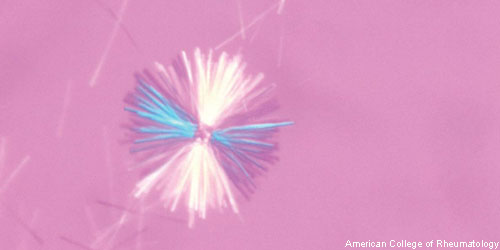 Gout is one of the most common inflammatory arthritis diseases, affecting 8.3 million adults in the U.S.1 It’s also one of the most preventable and treatable diseases, but only 32–58% of patients receive adequate gout treatment, indicating significant room for improvement of care.2
Gout is one of the most common inflammatory arthritis diseases, affecting 8.3 million adults in the U.S.1 It’s also one of the most preventable and treatable diseases, but only 32–58% of patients receive adequate gout treatment, indicating significant room for improvement of care.2
For this reason, the ACR supported a group that developed several electronic clinical quality measures (eCQMs) that aim to close this gap. These measures give rheumatologists the chance to measure their performance in key areas of gout care, including gout care management, management of urate-lowering therapy, management of patients on urate-lowering therapy, serum urate monitoring and management, allopurinol-specific considerations and gout flare prophylaxis.
“These quality measures are shining a light on gout to show the quality of care being provide to patients with gout and how patients are doing to help us improve patient outcomes,” says John FitzGerald, MD, PhD, interim chief of the division of rheumatology at Ronald Reagan UCLA Medical Center, Los Angeles. As a leader in gout research, Dr. FitzGerald led the ACR group’s work to shape these eCQMs and coauthored a paper outlining the development of these measures.2
Clinical Takeaways
To support rheumatologists and their colleagues in improving gout care management, Dr. FitzGerald outlines five practice takeaways from the eCQMs.
1. Identify gout patients with hyperuricemia in need of urate-lowering therapy: The first step in managing gout is to identify gout patients with hyperuricemia who require urate-lowering therapy, he says. According to the eQCMs, if a patient with gout has a serum urate (sUA) level greater than 6 mg/dL and has tophus/tophi development of two or more attacks per year, then urate-lowering therapy should be prescribed. This therapy will improve sUA levels, decrease the risk for recurrent attacks and reduce tophus deposition.2
2. Know the treat-to-target threshold for urate levels: Any patient with active gout on urate-lowering therapy should have their serum urate level checked at least once annually—at a minimum and regardless of disease activity. These patients should not have a sUA level above 6.8, according to the eQCMs. For patients being managed for active gout, the ACR recommended treatment target remains less than six, and less than five for patients with severe gout.
However, quality measures are meant to define a minimum threshold for all patients. Through this measure, a patient whose gout has been quiescent for years with <6 serum urate <6.8 mg/dL would not be incentivized to change urate management just for the purpose of lowering serum urate to less than 6 mg/dL if the patient was clinically doing well.


